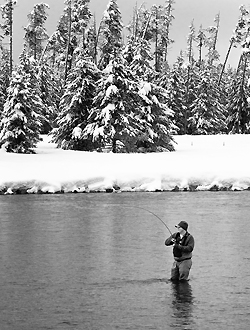 For several decades, it has been generally understood that fishing on the Henry’s Fork is shaped during the season when the least amount of opportunity is available. And while it is true that seasonal closures on some stretches of the river can provide relief to beleaguered trout that must withstand near constant human disruption for nearly half of the year, it is the influence of winter weather patterns that largely determine the status of the fishery.Even in late April one takes a serious risk in pronouncing the end of a winter essentially free of extremes in temperature or precipitation, but a 70 degree day and a good caddis hatch nudge caution aside just enough to take a chance.
For several decades, it has been generally understood that fishing on the Henry’s Fork is shaped during the season when the least amount of opportunity is available. And while it is true that seasonal closures on some stretches of the river can provide relief to beleaguered trout that must withstand near constant human disruption for nearly half of the year, it is the influence of winter weather patterns that largely determine the status of the fishery.Even in late April one takes a serious risk in pronouncing the end of a winter essentially free of extremes in temperature or precipitation, but a 70 degree day and a good caddis hatch nudge caution aside just enough to take a chance.While cold days in January and February were the general rule, the river was spared the kind of destructive icing that can occur during extended stretches of subzero temperatures. Noticeably absent, however, was the abundance of dry fly opportunity with midges and Baetis that was enjoyed during the same period in 2012.
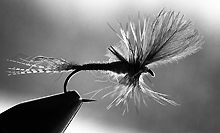
At slightly below average, this year’s snowpack wasbetter than most other drainages in the region, and Island Park Reservoir stands at about 90% of capacity. Both are positive signs looking forward but more important were the flows during the period most critical for juvenile trout survival. Once again, representatives from the Henry’s Fork Foundation and Idaho fish and Game Department were successful in negotiating winter release from Island Park Reservoir that would minimize trout loss and damage to their habitat. The ongoing cooperative relationship involving this collective voice for the Henry’s Fork fishery and those who manage irrigation and hydroelectric interests is something to be appreciated by all who care for the river.
Perhaps the best news leading into the new season is the completion of a 3 year repair
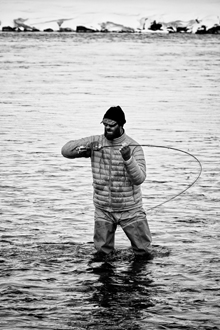
project on Ashton Dam. Considered by many to be one of the most productive stretches of the lower river, the water downstream from the project appears to have escaped major damage as a result of draining Ashton Reservoir and other alterations associated with the repair work. However, there is no disputing the disruption to hatches during this period which translated to a weakened opportunity for rising trout. Most experts predict a return to former levels of productivity rather quickly with a refilled reservoir and normal operations at the dam.
With temperatures averaging 10-15 F below normal through late winter and early spring, conditions conducive to dry fly fishing have been relatively sparse. Adding personal experience to reports from local guides who tolerate the cold much better than a guy in his late sixties, there is small concern for the size, numbers, and condition of trout in all sections of the river not subjected to seasonal closure. Nymph and streamer fishing have been consistently reliable methods on all but the coldest days from November through mid-April.
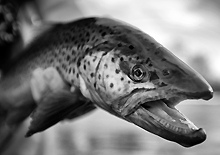 Spawning evidence last fall indicates an especially strong population of brown trout on the lower Fork while current rainbow activity on the redds from Box Canyon downstream to St. Anthony shows no sign of weakness.
Spawning evidence last fall indicates an especially strong population of brown trout on the lower Fork while current rainbow activity on the redds from Box Canyon downstream to St. Anthony shows no sign of weakness.Idaho fish and Game biologists typically begin population surveys sometime during the month of May with reports being presented to the public by early June. Also expected is a report from HFF staff members who monitor the fish ladder connecting the Buffalo River to the Henry’s Fork.
Even in the dead of winter I am seldom away from the river more than 3 days in a row. Just watching occupies more time than actual fishing until I begin to see enough noses to justify pulling on the waders. Midges can happen in any month and I have often found fishable hatches of Baetis in February. This year, however, it was well into March before subzero temperatures became something less than a common feature. When combined with some of the heavier snow storms of the season, it should be easy to understand why dust continued to accumulate on my 4 wt. for a month longer than usual.
Days that otherwise might have been ideal for surface action were plagued by a pesky north wind that dictated a 6 wt and something fished underneath, but I was occasionally teased by a brief display of rising trout as the calendar flipped to April.
 Remarkable to me is how quickly spring hatches have responded to the arrival of temperatures more appropriate to the season. Overcast days with even 40degree temperatures can be suitable for an appearance of Baetis, provided the wind is not coming from the Artic Pole. A dozen or so hours spread over the first two weeks of April provided enough dry fly business to shake off the rust from an extra month of winter, and anticipation ruled as budding willows along the water’s edge announced the arrival of spring. Almost overnight, aggressive rises to something larger than size 20 became a daily feature on the water near St. Anthony as spring caddis and March Browns began to replace tiny midges and mayflies as primary menu items.
Remarkable to me is how quickly spring hatches have responded to the arrival of temperatures more appropriate to the season. Overcast days with even 40degree temperatures can be suitable for an appearance of Baetis, provided the wind is not coming from the Artic Pole. A dozen or so hours spread over the first two weeks of April provided enough dry fly business to shake off the rust from an extra month of winter, and anticipation ruled as budding willows along the water’s edge announced the arrival of spring. Almost overnight, aggressive rises to something larger than size 20 became a daily feature on the water near St. Anthony as spring caddis and March Browns began to replace tiny midges and mayflies as primary menu items.Warmer days bring melting snow and as May approaches, it appears that flows and hatches are on a path to what would normally be expected. Tributaries downstream from Island Park that carry runoff to the Henry’s Fork have begun to swell as temperatures inch beyond the 70 degree mark. As the rainbow spawn reaches conclusion, trout will begin to disperse from winter habitat. Higher river levels allow larger fish to find comfort along previously vacant banks and into contact with drifting anglers. This becomes especially important as Salmon Fly nymphs begin migrating toward the edges in preparation for emergence.
As early caddis and mayfly hatches begin to tail off in mid-May on the lower river, guides, and others of experience will transition into big trout mode with hefty Black Rubber Legs and other patterns that can be mistaken for a Salmon Fly Nymph. Late May and early June are target times for adult salmon flies, but the nymphs are of keen interest for up to two weeks in advance of this much anticipated event.
While adequate by most standards, the current snowpack is not expected to produce severely elevated flows or the flooding that can occur in exceptional years. And while weather extremes can bring short term disruption to trout and insect activity, I am seeing no indication that fishing on the Fork will be anything less than last year, which most will agree was excellent.
Generally speaking, trout and insect populations are as healthy as I have seen since late in
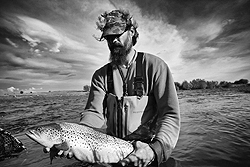 the last century, and the known factors that contribute to this status appear to be continuing. Key among those factors is a continuation of winter flows that accommodate a high survival rate of trout and protection of their habitat. Reconnection of tributaries to the Henry’s Fork within the Caldera also seems to play a role in the health of the fishery, and rehabilitation projects are ongoing.
the last century, and the known factors that contribute to this status appear to be continuing. Key among those factors is a continuation of winter flows that accommodate a high survival rate of trout and protection of their habitat. Reconnection of tributaries to the Henry’s Fork within the Caldera also seems to play a role in the health of the fishery, and rehabilitation projects are ongoing.To an extent that is difficult to express, my respect goes to the Henry’s Fork Foundation, Idaho Department of Fish and Game, and the U.S. Forest Service. At no time in my memory has the river benefitted more from the organizations assigned to its protection. Ultimately, the well-being of the Henry’s Fork lies in the hands of nature, but the fishing we enjoy continues to be dependent upon the assistance of mankind.
